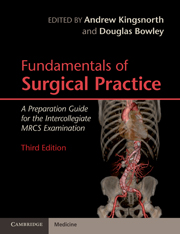Book contents
- Frontmatter
- Contents
- List of contributors
- Preface
- Section 1 Basic Sciences Relevant to Surgical Practice
- Section 2 Basic Surgical Skills
- Section 3 The Assessment and Management of the Surgical Patient
- Section 4 Perioperative Care of the Surgical Patient
- Section 5 Common Surgical Conditions
- 16 Assessment and early treatment of patients with trauma
- 17 Fundamentals of the central nervous system
- 18 Fundamentals of head and neck surgery
- 19 Fundamentals of thoracic surgery
- 20 Oesophago-gastric surgery
- 21 Fundamentals of hepatobiliary and pancreatic surgery
- 22 Fundamentals of endocrine surgery
- 23 Fundamentals of the breast
- 24 Lower gastrointestinal surgery
- 25 Fundamentals of the genitourinary system
- 26 Hernias
- 27 Fundamentals of vascular surgery
- 28 Fundamentals of orthopaedics
- 29 Fundamentals of plastic surgery
- 30 Surgical care of the paediatric patient
- 31 Fundamentals of organ transplantation
- Index
- References
25 - Fundamentals of the genitourinary system
Published online by Cambridge University Press: 03 May 2011
- Frontmatter
- Contents
- List of contributors
- Preface
- Section 1 Basic Sciences Relevant to Surgical Practice
- Section 2 Basic Surgical Skills
- Section 3 The Assessment and Management of the Surgical Patient
- Section 4 Perioperative Care of the Surgical Patient
- Section 5 Common Surgical Conditions
- 16 Assessment and early treatment of patients with trauma
- 17 Fundamentals of the central nervous system
- 18 Fundamentals of head and neck surgery
- 19 Fundamentals of thoracic surgery
- 20 Oesophago-gastric surgery
- 21 Fundamentals of hepatobiliary and pancreatic surgery
- 22 Fundamentals of endocrine surgery
- 23 Fundamentals of the breast
- 24 Lower gastrointestinal surgery
- 25 Fundamentals of the genitourinary system
- 26 Hernias
- 27 Fundamentals of vascular surgery
- 28 Fundamentals of orthopaedics
- 29 Fundamentals of plastic surgery
- 30 Surgical care of the paediatric patient
- 31 Fundamentals of organ transplantation
- Index
- References
Summary
Urology is the study of diseases of the urinary tract and the male reproductive system. Some of the earliest operations described are urological procedures and the ancient Egyptians are known to have performed circumcision, surgical castration and cystolithotomy (open removal of bladder stones).
Functional disorders of micturition may lead to urine incontinence or urine retention. Metabolic abnormalities may result in renal stone disease. Developmental abnormalities are seen in the neonate and the developing child. Urological cancers are common and their management can affect continence, fertility and quality of life.
Despite the numerous diseases that can affect the urinary tract, the presenting symptoms are few, making accurate diagnosis dependent on the careful imaging of structural abnormalities as well as a functional assessment of voiding and renal function.
Anatomy and developmental anomalies
Kidney
Gross anatomy
The adult kidney, a paired organ, is approximately 11 cm long, weighs 150 g and lies in the retroperitoneum. Posteriorly, the upper half lies on the diaphragm with the psoas, quadratus lumborum and transversus abdominis muscles from medial to lateral on the lower half.
Anteriorly, the right kidney is covered on its medial aspect by the second part of the duodenum and the liver overlying the upper pole and hepatic flexure of the colon covering the lower part of the anterolateral aspect.
- Type
- Chapter
- Information
- Fundamentals of Surgical PracticeA Preparation Guide for the Intercollegiate MRCS Examination, pp. 453 - 479Publisher: Cambridge University PressPrint publication year: 2011

